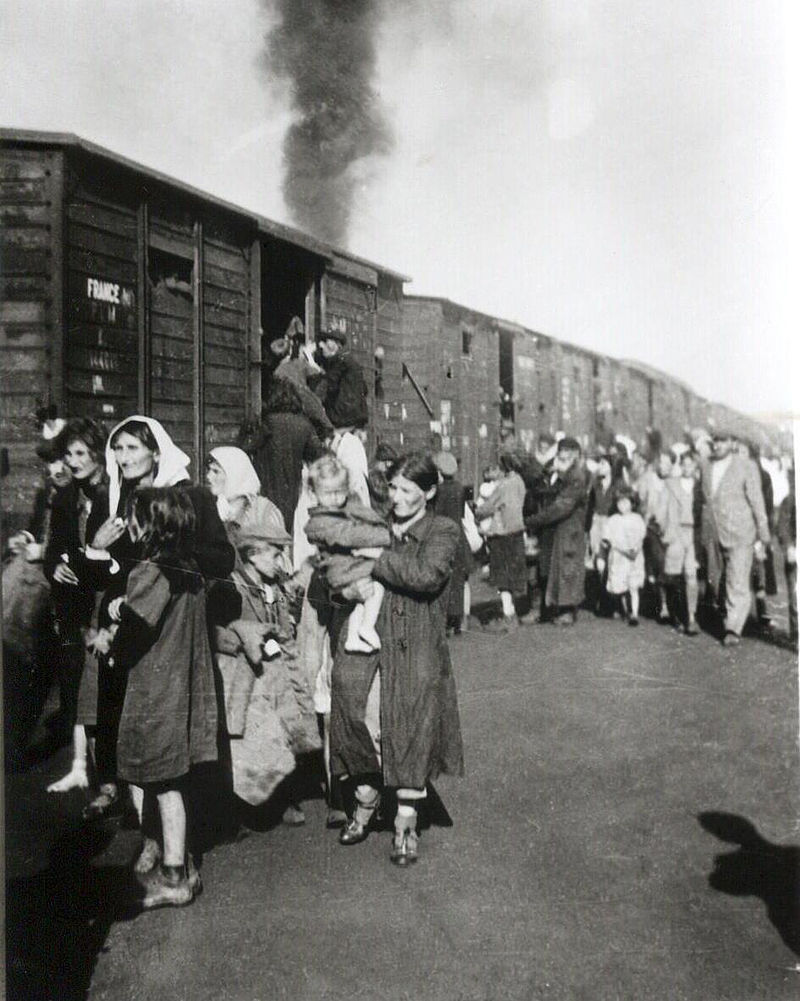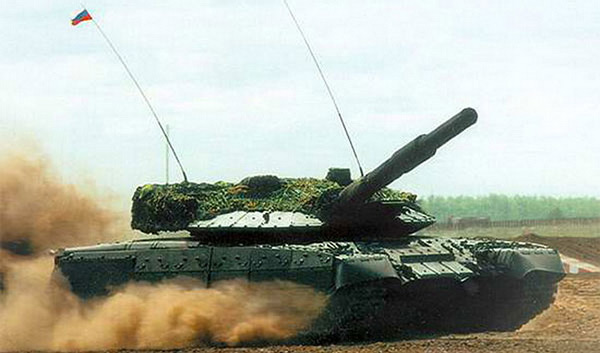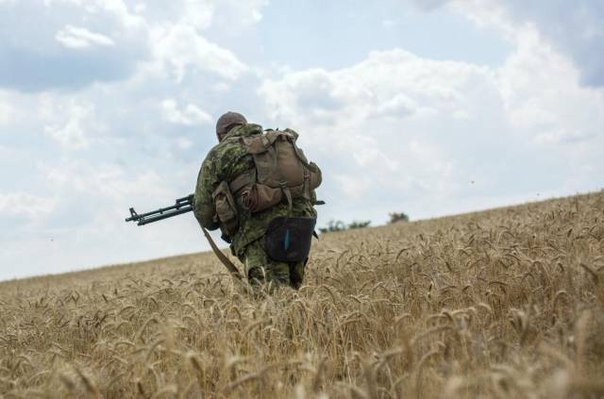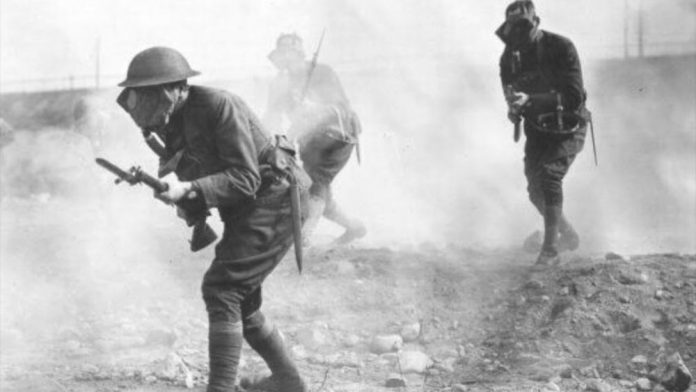
It is not known exactly, when man first used chemical weapons, but still in the Stone Age people used acrid smoke fire, vykurivaya animals from their dens. Then, acquainted with the plant and animal poisons, people began to use them for hunting or war. Light Arrows South American Indians, smeared with curare or secretions of tree frogs - is also a chemical weapons. true, poisons, which poisons the arrowhead, swords or daggers, in ancient times it was considered weapons of dishonest people. In many armies of the past use of poisoned weapons were strictly forbidden.
However, this prohibition does not apply to the smoke of fires, in which gradually began to throw not only the wet grass and leaves. Toxic fumes and gases originally used in a completely peaceful purposes - to combat the bloodsucking parasites. In Egypt and China for this fumigated premises. But already in the II millennium BC in ancient India in the fire were throwing armfuls of cannabis - its intoxicating smoke of enemy soldiers.
In Chinese manuscripts, dated IV century BC. e., It mentions the use of poisonous gases to deal with a tunnel under the walls of the enemy fortress. Into enemy tunnels defenders using bellows and terracotta pipes sent smoke from burning sage and mustard seeds. Used chemical agents in their wars and ancient Greeks: So, during the Peloponnesian War (431-404 years BC) Spartans underlay under the walls of besieged cities burning logs, filled with resin and sulfur.
In the era of gunpowder
Later, with the advent of gunpowder, on the battlefield began to use bomb, filled with a mixture of venoms, powder and resin. Fired from catapults, they exploded from the burning wick (prototype of the modern remote detonator), Clubs emitting toxic smoke over the enemy troops.
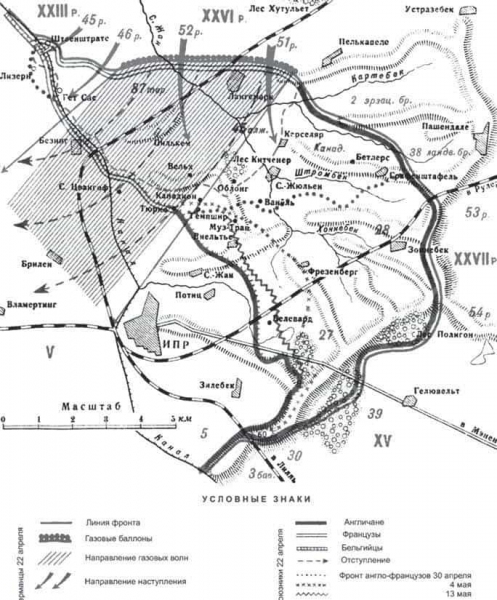 Schematic map of the first gas attack Germans at Ypres, 22 April 1915 g
Schematic map of the first gas attack Germans at Ypres, 22 April 1915 g
In medieval China was invented cardboard bomb, stuffed with sulfur and lime. known, Such bombs were used during a sea battle in 1161 year. Falling into the water, They exploded with a deafening roar, spreading toxic smoke in the air, which causes the same effects, and that a modern tear gas. Also sulfur and lime, to bomb the Chinese equipment used and other components: knotweed hooked, croton oil, soap pod tree (for the formation of smoke), sulphide and arsenic oxide, aconite, tung-oil, španskie male.
At the beginning of the XVI century, the inhabitants of Brazil tried to fight the conquistadors, "Fumigating" their poisonous smoke from the bonfires of red pepper .... This method has been regularly used in the uprisings in Latin America.
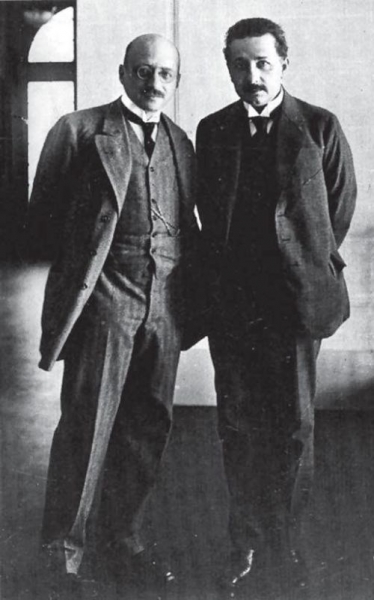 Haber and Einstein, Berlin, 1914 g.Frits Haber (Fritz Haber, 1868-1934) He was honored in 1918 was the title of laureate of the Nobel Prize in chemistry for synthesis 1908 by liquid ammonia from nitrogen and hydrogen at osmium catalyst. During the war, he led the chemical service of the German troops. After the Nazis came to power was forced to leave in 1933 g. as director of the Berlin Institute of Physical Chemistry and Electrochemistry (I took him in 1911 city) and emigrated - first to England, and then to Switzerland. He died in Basel 29 January 1934 g.
Haber and Einstein, Berlin, 1914 g.Frits Haber (Fritz Haber, 1868-1934) He was honored in 1918 was the title of laureate of the Nobel Prize in chemistry for synthesis 1908 by liquid ammonia from nitrogen and hydrogen at osmium catalyst. During the war, he led the chemical service of the German troops. After the Nazis came to power was forced to leave in 1933 g. as director of the Berlin Institute of Physical Chemistry and Electrochemistry (I took him in 1911 city) and emigrated - first to England, and then to Switzerland. He died in Basel 29 January 1934 g.
In the Middle Ages chemicals continued to be used for military purposes. So, at 1456 Belgrade, the city defended by the Turks including the use of the original "chemical weapons". Residents sprinkled rats toxic powder, They set fire to them and produced to meet the besieging.
During the Crimean War the English admiral Lord Dendonald offered his government project is the capture of Sevastopol with the help of five hundred tons of burning sulfur. Ad hoc committee, Check all details of the project, He suggested, that it is quite feasible and promised them results, undoubtedly, can be achieved; but by themselves these results so terrible, that no honest enemy should not take advantage of it. On this basis, the Committee decided, The project can not be accepted, and a note Dendonalda Lord must be destroyed. Nevertheless, some "stinking bombs" British during the Crimean War is still used.
So, Entries Russian Vice Admiral MF. Reineke record exists, dated 13 May 1854 of the year: «…Today in Sevastopol brought from Odessa two stinking bombs, abandoned the city 11 April, British and French ships. One of them began to open in the courtyard of Menshikov in the presence of Kornilov, and especially a perfect opening sleeve unbearable stench so much pour all, that Kornilov fainted; therefore ceased to unscrew the plug and gave the two bombs in the pharmacy for the expansion of their composition. A similar bomb was opened in Odessa, and gunners, it reveals, fainted, received severe vomiting».
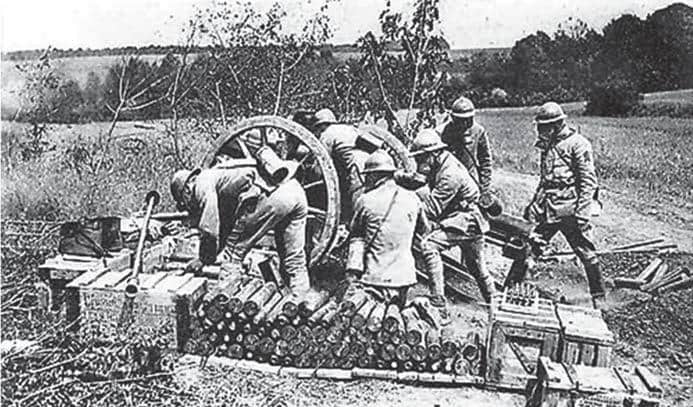 French gunners firing chemical shells
French gunners firing chemical shells
In Russia, the first tests of chemical weapons were carried out in the late 50-ies of the XIX century in the Volkov Field. ammunition, načinennye cianistym cacodyl, They were undermined in the open log cabins, where there were 12 cats. All cats are alive. As a result, erroneous conclusions about the low efficiency of toxic substances, and work on testing missiles, infested with toxic substances, They were discontinued and resumed only in the midst of World War II - in 1915 year.
It should be noted, that the Russian top leadership at all before the war, are very sensitive to all kinds of international conventions and agreements, that weapons of this type were forbidden. In accordance with the Hague Declaration 1899 of the year, the provisions of which took France, Germany, Italy, Russia and Japan, which in 1907 she joined the UK, the parties agreed on the non-use of asphyxiating gases and nerve agents for military purposes.
Given the international bans, negative attitude to the poisoners, and no need of the military in the new,more lethal weapons, widespread use of chemicals for military purposes was held back until the beginning of the XX century.
World War I
But, as is known, military confidence that time is, that the future world war will maneuverable character and win it will be possible to use the 3-inch guns, It was ruthlessly smashed the course of the campaign 1914 of the year. Fighting acquired positional, troops buried in the ground, sheltered from the enemy in the trenches and dugouts.
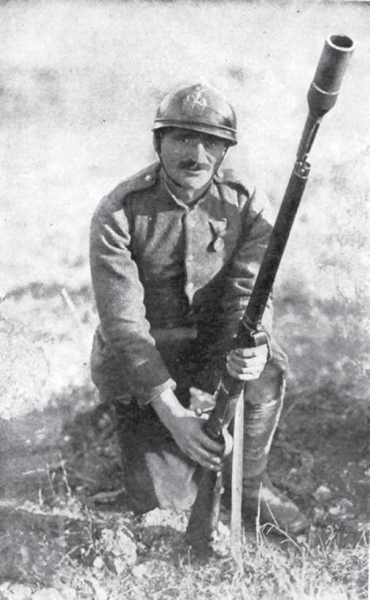 French soldier with 26 mm chemical rifle grenade
French soldier with 26 mm chemical rifle grenade
By the end 1914 , Germany exhausted the possibilities for large-scale offensive on the Western Front. After the battle of the Marne, stretching over the front 700 km steadied. All along the front line stretched two continuous lines of trenches, one against another, braided rows of barbed wire. Both parties applied efforts to build defensive structures - create additional trenches with an extensive line of moves, built concrete pillboxes and bunkers. Break through a layered defense line forces infantry formations, even with the support of artillery was virtually impossible. And this despite the fact, that in the September battles 1914 year on the rivers Marne and En opponents felt the shortage of artillery shells. Therefore, the two warring sides frantically started searching for new means of destroying the enemy in places, not available actions most powerful shells.
One way of overcoming the crisis was the offensive use of poison gases. That the Germans considered to be inhumane initiate chemical warfare. However, from the beginning of the First World War, the possibility of using chemicals in the fighting and sought British. And if at first they tended to non-lethal toxic agents, capable of causing watery eyes (in January 1915 Tear years successfully been tested etiliodoatsetata), the unfavorable development of the fighting has forced the British to look more dangerous chemicals. However, in England, there was no good ideas on the development and use of chemical weapons, no people, able to make decisions and organize the work in this area.
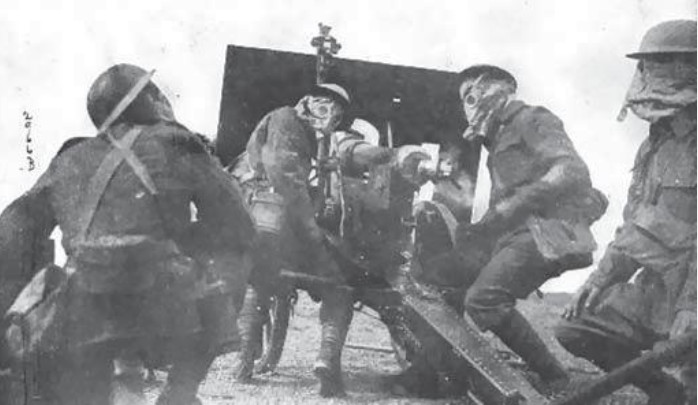 Calculation of the British guns firing chemical shells
Calculation of the British guns firing chemical shells
For its part, the Germans were aware of the interest of the Entente for use in war of chemical weapons. A technical level of the chemical industry, multiplied by the high scientific potential, Germany has allowed to develop its own strategy of offensive chemical warfare. Therefore correct to consider, that does not belong to Germany "initiative", and the "lead" in the application of toxic substances.
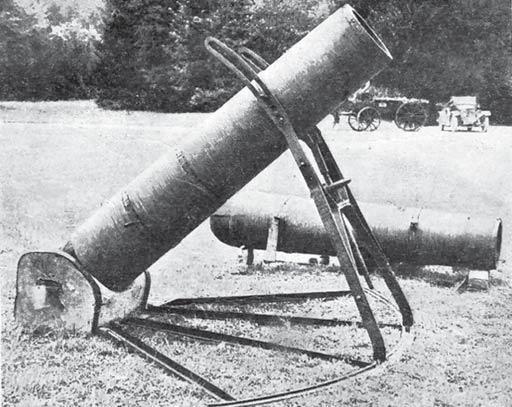 German trench, the wooden mortar obr.1915, Used for firing chemical mines
German trench, the wooden mortar obr.1915, Used for firing chemical mines
Father of German combat chemical agents and its application is considered to be the German chemist Dr. Fritz Haber, Head of the Institute of Physical Chemistry and Electrochemistry imenikayzera Wilhelm. One of the greatest scholars of his time, proposed a method for the synthesis of ammonia from the air, Nobel Prize in Chemistry 1918 of the year, Haber was on friendly terms with such luminaries of science, as Albert Einstein and Max Planck.
When the war began, Haber, full of romantic patriotism, He was one of the scientists, offered them his services. He saw in the use of poison gas way to change the situation at the front. Haber was convinced, that the use of asphyxiating gas is much more humane, than shelling, since the gas does not cause the enemy terrible wounds, and the success achieved solely by the psychological effect. Fritz Haber thought, that the use of chemical weapons would lead the Allies to the idea of a speedy conclusion of peace.
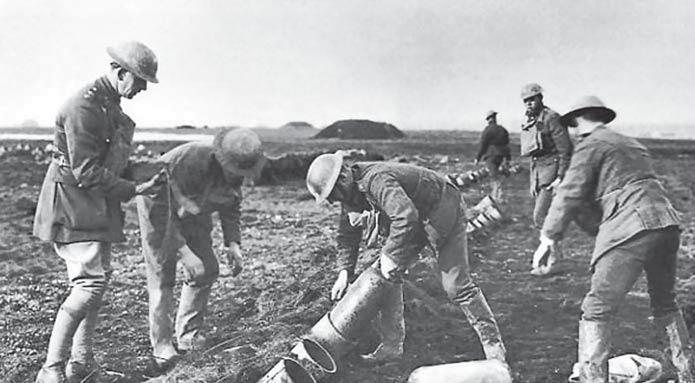 British charge trench GAZOMET chemical mines
British charge trench GAZOMET chemical mines
Immediately after the declaration of war in the Kaiser Wilhelm Institute have begun experiments with cacodyl oxide with phosgene to explore the possibility of using them in warfare. true, soon interrupted experiments occurred in a lab explosion. it, but, It did not affect the overall progress of research and, the main thing, organizational measures. So, Berlin Military Gas school was opened, and special chemical inspection was formed under Ministry of War A-10, specifically deals with issues of chemical warfare. Center for the production of chemical warfare agents began to Leverkusen, where in 1915 year was translated and military chemical school. By this time it counted 1500 person technical team and staff, and several thousand workers were employed in manufacturing. Only one of its branches - the lab in Gyushte - worked non-stop 300 chemists.
The first development of the Military School of the gas was the so-called "shell №2» - 10,5-cm shrapnel, where black powder was replaced by sulfate dianisidine. Although the explosive effect of such shells nullified the possible effect of the chemical charge, but the first step to a massive use of toxic substances in the fighting was done - 27 October, the shell has been applied on the western front in the attack on Neuve Chapelle in an amount 3000 PC. Although it was small irritant, but, on the German data, its application facilitated the capture of Neuve-Chapelle. In the future, "the projectile №2» was withdrawn from service.
In January 1915 the Germans finished the development of new chemical projectile, known under the name "T" - 15 cm artillery grenades blasting with strong irritant effect and chemical (xylyl bromide), subsequently replaced bromoacetone and brometilketonom. Shell structure "T" developed by Dr Hans von Tappen.
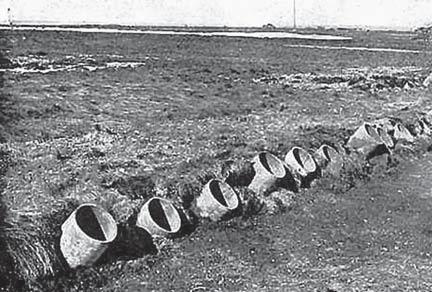
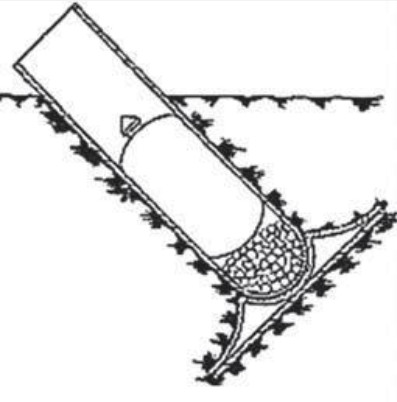 English GAZOMET on position
English GAZOMET on position
Referring to the exact wording of the Hague Declaration, Germany 27 October 1914 for the first time applied the shrapnel ammunition, citing the fact, that chemical exposure is not the only purpose of the shelling. In late January, the Germans used them, and at the front on the left bank in the area of Poland Bolimova, but chemically unsuccessfully, due to low temperature and insufficient massaging shooting.
In April, at Nieuport in Flanders the Germans for the first time experienced the effects of his grenades "D", containing a mixture of benzyl bromide and xylyl.
In January 1915 , the French sent to the front its chemical 26-mm rifle grenades, but their use has been postponed, since the troops have not been trained in their use, Besides, and there was no remedy. Their, and similar hand-held chemical grenades French began using in March, but also without any appreciable results.
In this way, first attempted use of chemical warfare agents were conducted in a small scale and with such a slight effect, that was not even taken any concrete measures to the line protection equipment.
In this situation, higher German command rightly doubted the efficacy of a gas projectiles, Besides, in this period, at the front and acutely felt the lack of the usual shells. As a result, Dr. Haber put forward the idea to use poison gas in a gas cloud. As it is a chemical agent chosen chloro, which is produced in large quantities in Germany before the war (at 1914 in Germany was carried out on a daily basis 40 tons of chlorine). Haber proposed chloro stored and transported in liquid form, under pressure, in steel cylinders. Cylinders must be delivered naboevye position, and in the presence of a tailwind chloro produced toward enemy positions.
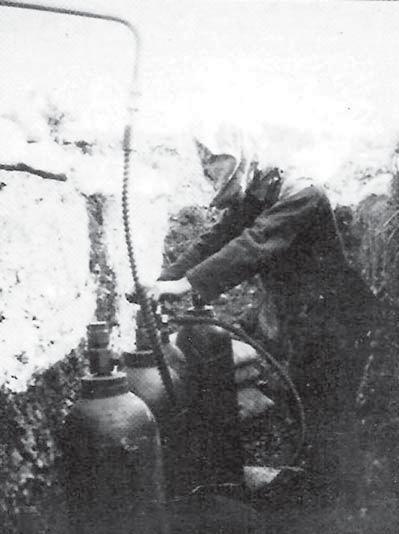 Military chemist separates the gas cylinder valve to start gas attack
Military chemist separates the gas cylinder valve to start gas attack
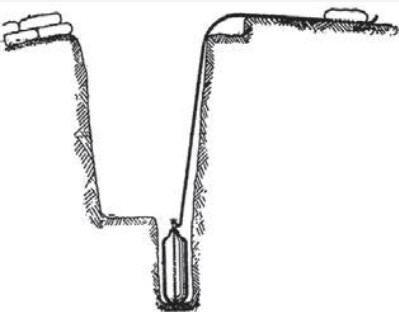 Scheme installation in the trench gas cylinder
Scheme installation in the trench gas cylinder
western front
The decision to use gas against the Anglo-French forces was taken in early 1915 of the year, field experience has been defined the western sector of the front, forming a protrusion, in Ieper area (a small town in the north of Belgium). However, an extremely skeptical attitude of the German leadership to the tactical possibilities of toxic substances led to, that initially the use of poison gas at Ypres examined by a military leadership of Germany as a means of testing the destruction of enemy personnel, and not as a tactical means of defense breakthrough. On this basis a request command XV Corps, at the site where the attack was carried out, the allocation of a large quantity of ammunition to use and secure possible success, if any, will be achieved with experience, It indicated, any thought of the general operations about Ypres completely meets the intentions of the High Command and the body must produce only the test of a new weapon.
Initially, the front section has been chosen for the chemical attack, located in the north-eastern part of the ridge Iprskogo, in the place, a convergence of the French and English sections of the Defense. As a result of analysis of meteorological observations the High Command were convinced, that a new weapon is best to test during the coming reign of southerly winds, what best suits the front section XV-th German corps, turn north.
Burying the first test gas cylinders at the site of the front XV Corps was completed in mid-February. Then the width of the sector was slightly increased, so to 10 March entire front XV Corps was prepared for a gas attack.
but 25 in March the commander of the 4th Army decided to move the location of the gas attack on the site of the 46th Reserve Division and the XXVI Reserve Corps - Pelkappele-Shteenshtrat. TO 11 April 6-kilometer section was dug in order 6 thousands of gas cylinders (half of them was a conventional commercial type requisitioned in "economy"), filled with chlorine. In total there are Germans have accumulated 160 tons of liquid chlorine. The first application of its "child" decided to present himself Dr. Fritz Haber.
However, it took almost two weeks to, to wait for the right sustainable south or south-west wind. During this period, some of the gas cylinders, although buried, It was damaged by accidentally hitting the enemy artillery shells.
Such a long preparation did not go unnoticed. A few days before the first gas attack captured German soldier with gas mask was captured, who claimed, that the German High Command intends to poison your enemy cloud of gas and that the gas cylinders have been installed in trenches. Although his testimony confirmed by aerial reconnaissance, but still did not believe him - such an operation seemed impossible. This information appeared even in the intelligence reports of the Main Staff, but it was ranked among the "information, not trustworthy ".
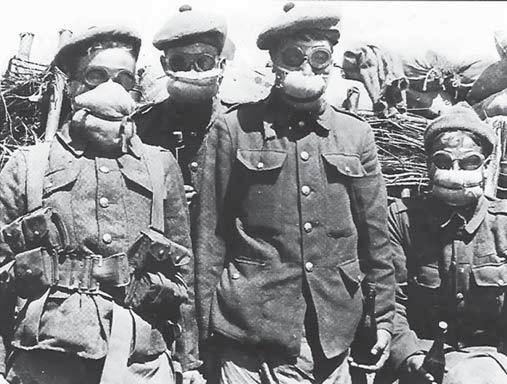 Servicemen Argayllshirskogo Saterlendskogo haylenderskogo (Mining and Scottish) regiment demonstrate the latest gas proof protection means, received 3 May 1915 city, - eye protection and a mask made of cloth
Servicemen Argayllshirskogo Saterlendskogo haylenderskogo (Mining and Scottish) regiment demonstrate the latest gas proof protection means, received 3 May 1915 city, - eye protection and a mask made of cloth
Finally, Germans waited for "tailwind" and 22 April 17 hours began gas attack. It was made in Pelkappele-Shteenshtrat sector and, according to the order of the 4th Army, gave 8 April, It was designed to capture the hill Pilkov and areas to the west of it.
Simultaneously with the start-up of gas began shelling from heavy guns. AT 17 time 30 min German infantry rose from the trenches and went on the offensive on the positions of the Anglo-French troops. A little later, he opened fire and the German field artillery, is silent before due to concerns disturb the free flow of gas in the desired direction.
Of the total number of gas cylinders harvested one-third was used in the attack. Gas wave output lasted 5 min. Actions on the flank of the attack intensified firing chemical shells.
Applied chloro Germans had a strong irritating effect on the respiratory system and the mucosal tissues all, are in their, causing laryngeal spasms and eye burning sensation, nose and throat, followed by bronchitis and pulmonary edema; lasting effect of strong concentrations of gas leads to death by asphyxiation, and in some cases heart enlargement or blueness of the skin as a result of lung disease.
The main "impact" of the gas cloud fell on the location of the French Algerian Division (staffed by natives of the African colonies). According to the descriptions of British officers, German start watching the gas attack afar, at first, at 17 hours, It began a terrible bombardment of Ypres heavy howitzers. Also strong bombardment and nearby villages, until virtually untouched. At the same time the French field guns to the north-east of Ypres opened some rapid fire, Although the German field artillery silent. First, some officers, heard shots, thought, recently arrived Algerian Division "shot itself", but they, who was suitable for observation points, We saw two curious greenish-yellow cloud on the ground, on the other side Langemark, at the front of the German lines. Extending in the direction, these gas clouds rose up and, push forward the light wind, became bluish-white mist, this, which can be seen on a wet meadow in the frosty night.
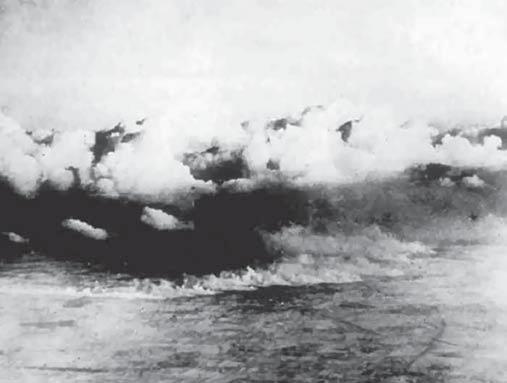 gas clouds, issued by the Germans during the first chemical attack at Ypres in April 1915 g. The picture was taken from the plane from the German positions
gas clouds, issued by the Germans during the first chemical attack at Ypres in April 1915 g. The picture was taken from the plane from the German positions
At first slowly floating greenish-yellow cloud has caused surprise and bewilderment of the French. But when the cloud reached the French trenches and the first victim, The panic began, developed into a rout. One witness describes what he saw: «person, hands of the people were of a glossy blue-black, mouths open, eyes covered with lead glaze, all around tossing, kružilosʹ, fighting for life. The sight was frightening, all these horrible blackened faces, wailing and pleading for help ...».
«French colored troops without officers rushed back over the rear road V Corps. Soon the French territorial troops were already in disarray crossed the bridge over the canal north of Ypres. It was impossible to understand, that saw the Africans, but on the strength of their cough and acute throat irritation it was clear, they suffered greatly; demoralization was complete. Harnessing and carts French Field Artillery, retreating to the rear, and fugitives crowd grew thick and disorderly. Some fled to Vlamertinga continue».
Gas penetrated into all the cracks shelters. Interesting, what people, stay put, suffered less, than those, who fled, since each movement intensified action of the gas. they, who were under fire, suffered less, than those, which lay or sat at the bottom of the trench. Most victims were wounded, lying on the ground or on a stretcher, and people, move in the rear, together with a cloud.
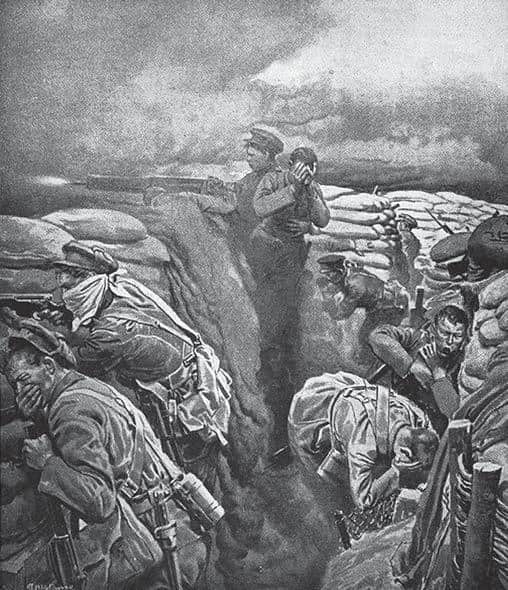 Picture the First World War, depicting episode gas attack
Picture the First World War, depicting episode gas attack
Advancing behind a cloud of German troops virtually unopposed. The exceptions were areas, where the action of the gas has been minimal. So, eg, fierce battle broke out in the area of road Pelkappele - Saint-Julien, where the Germans had to deal with the Canadian, unaffected gas attack. However, the disorderly retreat of the French troops, led to, that St. Julien was left, posed a threat to the environment for continuing to defend Canadians.
At the headquarters of the French command is continuously fed conflicting information. first thought, that the right flank of the French troops went to Pilkov. However, later it became clear, Pilkov that also left French. Actually, wide front portion 8 kilometers was thrown defending its parts. Road to Ypres was opened, and the Germans were free to develop the offensive, using the complete demoralization of the defenders. However, the German offensive was soon suspended parts, and they started digging. Anglo-French troops used the breathing space provided to them by the Germans to pull reserves and the resulting closure of breakthrough.
Extremely limited results of the German offensive on the ledge Iprskom, although here the Allies and suffered heavy losses - one was gassed up 15000 human, of them died 5000, It can be explained by the following factors. First of all, German commanders are wary of a new kind of arms, What is the poison gas, therefore do not associate with him the implementation of far-reaching plans skolkonibud. For this reason, parts, participating in the offensive, It was not allocated the necessary reserves, that would allow to develop the resulting success. Although the concentration of powerful reserves achieved tactical surprise would appeal to the Germans in the operational, forcing the allies to leave the Nieuport and Dunkirk, for the possession of which the Germans subsequently been spent so many fruitless efforts. In addition, the lack of effective means of chemical protection to its own troops hindered their progress on the territory, affected gases. Some sources claim, that the advancing German troops themselves have suffered from the action of chlorine, because they do not have any protective masks, no masks. Deciding on the use of chemical weapons, Command did not take care of, to provide effective protection of own troops.
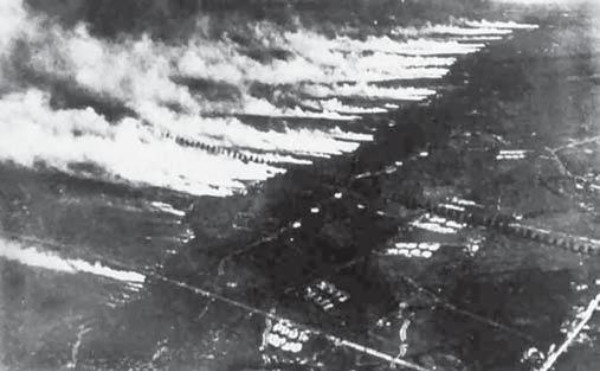
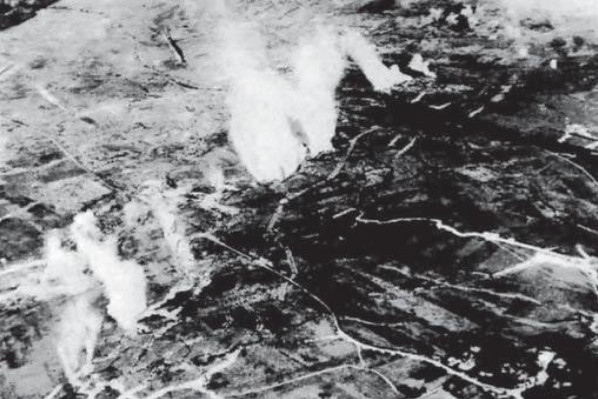 English gas-cylinders under attack Loos. The picture from the plane
English gas-cylinders under attack Loos. The picture from the plane
As a result,, Iprskaya successfully started operation could not develop into a full-scale offensive on the Western Front. The debate on possible options for the development of this offensive did not subside until now. Some authors are inclined to think, that the offensive would end in the defeat of the British and French troops and later to France out of the war.
But in any case there is no doubt the fact, Iprskaya operation that marks the beginning of "chemical warfare", that all the warring parties has been regarded as a panacea to overcome offensive crisis.
During May 1915 the Germans made another four gas-cylinder chlorine attack, accompanied by the firing of the British chemical shells in the area of Loos. According to estimates of the British General Staff, total losses for all four attacks were about 7000 human (of them died 350). Masks during the first two attacks were absent from the British, and in the last two they were primitive bandage. May all these chemicals attack the Germans in the British pursued a tactical objectives.
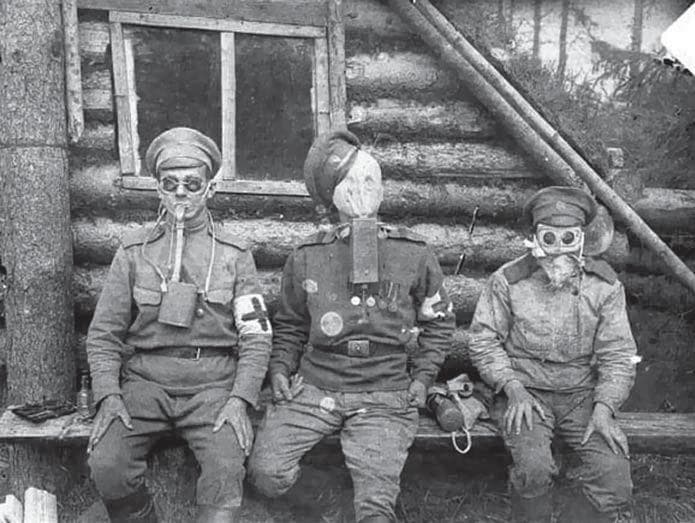 Russian soldiers in gas masks and gas masks
Russian soldiers in gas masks and gas masks
19 and 20 October the Germans had a gas bottle attack on French troops in the fort Pompelo, to the east of Reims in Champagne. This time they have used a mixture of chlorine and phosgene. During the attack, was released 500000 kg of gas at the front 17 km. French loss at first made gazopuske 1515 human (of them 253 dead) and the second - 3581 (of them 562 dead).
19 December the Germans attacked the British at Ypres in Flanders, using a mixture of chlorine with phosgene. Since the British already had masks, the great attention was paid to the surprise, stealth and speed of venting. As a result, the British lost 1069 human (of them died 127).
At the end 1915 the Germans expected to send a portion of the gas in Gallipoli for the production of compressed gas attacks in the Dardanelles operation. But as the British ceased offensive and cleared the Peninsula, this intention was not carried out.
To be continued…







